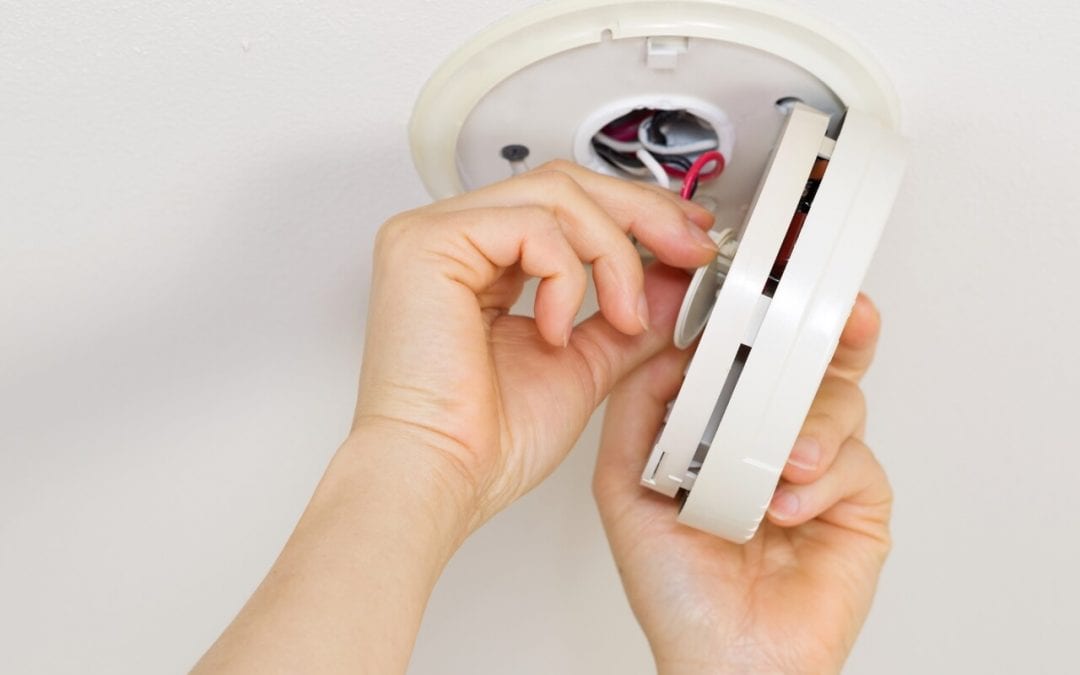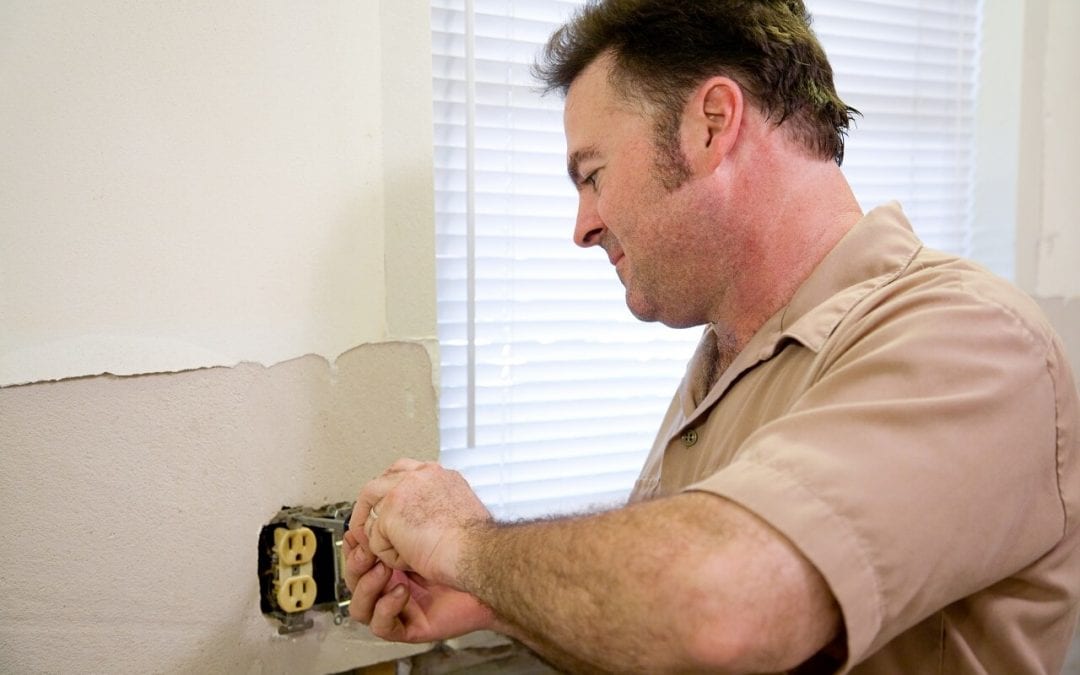
by mwonfor | Nov 16, 2020 | Community, Homeowners, Safe and Healthy Home
When homeowners consider home safety, protection against house fires comes immediately to mind. The most important defense against house fires is your smoke detectors. Statistics show that 3 out of 5 deaths due to house fires are in homes without working smoke detectors. Review these rules for proper smoke detector placement and make sure they are all followed in your home.
Rules of Thumb for Smoke Detector Placement
There are some basic, common-sense rules for smoke detector placement that should always be followed. While most people have heard them before, it is easy to let them fall by the wayside and cut corners.
- There should be at least one smoke detector for every level of the home.
- The smoke detector should be on the ceiling, or on the wall no more than 10 inches from the ceiling.
- Smoke detectors need to be tested monthly to make sure they are operational.
- A smoke detection device has a lifespan of about a decade.
- Change your smoke detector’s batteries when the time changes twice a year.
Commonly Forgotten Areas for Smoke Detectors
Some areas you may not think to install a smoke detector are the laundry room, basement, attic, and garage. Because of the rule that a smoke detector should be on every level, there should be one in the attic and basement whether the furnace is located there or not. Also, they should not only be inside every bedroom but outside of the bedroom doors in the hallways.
Things to Avoid With Smoke Detector Placement
Certain conditions can make a smoke alarm fail to detect smoke. Painting over a smoke detector or otherwise decorating it inhibits its ability to function properly. Don’t install a smoke detector near an air vent, ceiling fan, ventilation fan, or doorway because the movement of air can dissipate the smoke. You won’t be able to rely on your smoke detector to alert you to fire if they are installed in these locations.
American Home Inspection Services provides home inspections and related services to Southeast Michigan. Contact us to schedule an inspection.

by mwonfor | Aug 17, 2020 | Community, Homeowners, Safe and Healthy Home
Your home should be the place where your family is the safest and most comfortable. Regular maintenance is key to keeping your house in good condition. However, appearances aren’t enough. Follow the below five tips to keep your home healthy and safe for years to come.
1. Reduce the Risk of a Fire in Your Home
While no one can eliminate the threat of a fire, there are measures you can take to prevent one. Don’t overload any of your outlets. Make sure nothing is up against your furnace, baseboard heaters, and space heaters. Have fire extinguishers in the kitchen, basement, and garage. Install smoke detectors in several rooms throughout your home including all bedrooms, the attic, and the basement. Check your smoke detector batteries twice a year and replace the units every decade.
2. Prevent Mold to Keep the Home Healthy and Safe
Every homeowner dreads finding mold in their home. Mold is a living organism that makes your home unhealthy. It can wreak havoc on your health if you inhale its spores. It thrives in damp places, so the bathroom and basement are the most common areas where mold can show up. To keep your home healthy and safe from mold, control the moisture levels in your home. A ventilation fan protects your bathroom from growing mold. A dehumidifier and fans can keep your basement dry.
3. Minimize Dust
A buildup of dust in the home is not healthy. Dust mites and other tiny organisms breed in the dust. They can cause skin rashes and breathing problems. Dust is especially problematic for anyone who is allergic to dust, has asthma, or has other respiratory disorders. You can combat dust by dusting regularly with a microfiber cloth, keeping the surfaces clean in your home, and purchasing an air filtration device.
4. Keep Your Drinking Water Pure
The quality of your water is essential to keep a home healthy and safe. Most municipal and well water contains contaminants of some form. You have two options when it comes to purified water. You can either buy bottled water or you can install a water filter. Bottled water promotes waste and is expensive. A water filter comes with an initial expense that will offer you the return of clean drinking and cooking water for years to come.
5. Test for Radon to Make Your Home Healthy and Safe
Radon is a radioactive gas that is often found in the basement. It can increase your risk of lung cancer. Testing is the only way to find out the levels. If you do have high radon levels, hire a mitigation professional to make your home healthy and safe.
When you are conscientious, you can keep your home healthy and safe throughout the years. Reduce hazards like mold, dust, radon, house fires, and polluted drinking water with the above tips.
American Home Inspection Services provides water testing, radon testing, and other home inspection services to Southeast Michigan. Contact us to schedule our services.

by mwonfor | Mar 17, 2020 | Community, Homeowners, Safe and Healthy Home
Our elderly family members are more prone to falls and accidents in the home, which pose serious threats to their health and mobility. Problems with muscle strength, balance, and even side-effects of the medications they take can make them more vulnerable to injury from accidents. Here are 10 ways to make a home safe for seniors.
1. Remove or Secure Throw Rugs to Make a Home Safe for Seniors
Unsecured throw rugs are among the top causes of falls in older people. In most areas, it’s best to eliminate these rugs altogether. But if their use is necessary, such as in the bathroom, secure the rugs with double-sided tape to help reduce the risk of falls.
2. Add Bathroom Safety Features
Grab bars in the bathtub and shower provide stability and help prevent falls. Bath mats with rubber backing also help reduce the chance of slipping. A raised toilet seat is useful for seniors who have difficulty getting to their feet. Install a grab bar beside the toilet to offer extra assistance.
3. Install Extra Lighting in Stairways and Hallways
Impaired vision is a common problem as we age. Illuminate stairs, hallways, and other frequently traveled areas with additional fixtures or lighting that turns on when it senses movement.
4. Place Electrical Cords Out of the Way
Cords from lamps, TVs, and electronic equipment should be carefully tucked away to remove them as a tripping hazard. Don’t run cords under rugs, as this can cause overheating and lead to a fire.
5. Use Orange Tape for Floor Hazards to Make Your Home Safe for Seniors
Changes in flooring in the home, such as from hardwood to carpeting, can cause a fall. Steps from one room to another are also hazardous for elderly family members. Install bright orange tape in these transition areas to make them more visible and to help keep the home safe for seniors.
6. Keep Pets and Toys Out of Pathways
If older family members have significant mobility problems, keep pets confined to areas where they will not be underfoot. Similarly, children’s toys can be a hazard for seniors. Encourage children to keep toys in designated play areas in the home.
7. Prevent Medication Mix-ups
Keep medications in their original containers with attached labels detailing dosage and frequency. If needed, ask your pharmacist to provide large-print labels to make reading them easier. Medication alarm apps are helpful reminders for seniors to take their prescribed meds on time.
8. Cooking Hazards
Seniors should use care when cooking. Don’t allow them to wear loose-fitting clothing that could catch fire. Store food prep items in easy-to-reach areas so older family members don’t have to struggle to reach higher cabinets.
For some elderly people, cooking should be confined to the microwave. Make sure to test your fire alarms monthly and replace the batteries twice every year.
9. Rearrange Furniture to Provide Clear Walking Paths
Move items that block walking paths in each room. Replace glass coffee tables or shelves with other furniture that is less dangerous. Glass is more difficult to see and may shatter if a fall occurs. Remove items that may not be clearly visible and present a tripping hazard.
10. Use a Medical Alert System to Make Your Home Safe for Seniors
Medical alert systems have technology that allows the senior to call for help with the touch of a button, should they find themselves alone and in need of help.
Small changes make a big difference in your senior family member’s safety. Carefully inspect each part of your home, looking for potential hazards for someone who has impaired sight or mobility. Correcting these issues will keep the home safe and help prevent accidents.
American Home Inspection Services offers home inspection services to Southeast Michigan. If you’re buying or selling a home, contact us to request an appointment.

by mwonfor | Jan 16, 2020 | Community, Homeowners, Safe and Healthy Home
Address electrical problems in the home at the first indication of trouble. Ignoring these signs puts your family and home at risk for a house fire. The longer you delay the repair, the more damage can be done. Pay attention to signs of electrical problems and make a call for repairs as soon as you notice any of the below signs.
Flickering Lights are Signs of Electrical Problems in Your Home
Flickering lights are often caused by loose electrical connections. This can occur in a single light fixture or throughout the home. Both concerns need immediate professional attention, although the latter is a more serious sign of an electrical problem.
Hot Outlets
Electrical appliances generate heat when in use, but the outlet itself shouldn’t become hot. If you notice the outlet is warm to the touch, disconnect any cords and call a professional to troubleshoot the problem. Light switch covers follow the same rule, except in the case of dimmer switches which commonly generate some heat.
Aluminum Wiring
Aluminum wiring may comprise part or all of your electrical system. It was commonly used in the 1960s and 1970s when high copper prices caused builders to use aluminum instead. The aluminum oxidizes rapidly, which creates a fire risk in the home. Aluminum is no longer used in residential electrical applications. If you have aluminum wiring in your home, replace the wiring to improve fire safety.
Burning Smell
A burning smell is always a sign of trouble. The smell indicates that plastic sheeting around the wiring is melting. This problem poses a fire risk.
Loose Outlets Can Indicate Electrical Problems in Your Home
Many people notice loose outlets but fail to realize their potential danger. If you plug in an appliance and the outlet moves or the plug falls out, it’s time to make a quick fix. Left in this condition, the outlet will eventually loosen wiring within the walls which requires a more involved repair and increases the risk of fire.
American Home Inspection Services offers home inspection services to Southeast Michigan. If you’re buying or selling a home, contact us to request an appointment.




